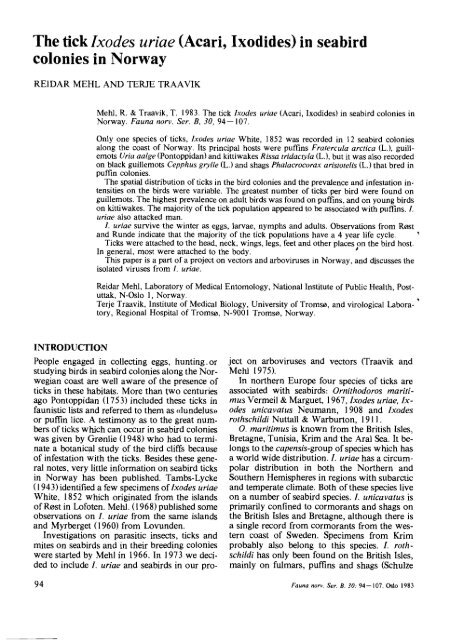Full-text - Norsk entomologisk forening
Full-text - Norsk entomologisk forening
Full-text - Norsk entomologisk forening
- No tags were found...
Create successful ePaper yourself
Turn your PDF publications into a flip-book with our unique Google optimized e-Paper software.
The tick Ixodes uriae (Acari, Ixodides) in seabirdcolonies in NorwayREIDAR MEHL AND TERJE TRAAVIKMehl, R. & Traavik, T. 1983. The tick Ixodes uriae (Acari, Ixodidesl in seabird colonies inNorway. Fauna norv. Ser. B, 30, 94-107.Only one species of ticks, Ixodes uriae White, 1852 was recorded in 12 seabird coloniesalong the coast of Norway. Its principal hosts were puffins Fratercula arctica (L.l, guillemotsUria aalge (Pontoppidanl and kittiwakes Rissa tridactyla (L.l, but it was also recordedon black guillemots Cepphus grylle (L.l and shags Phalacrocorax aristotelis (L.l that bred inpuffin colonies.The spatial distribution of ticks in the bird colonies and the prevalence and infestation intensitieson the birds were variable. The greatest number of ticks per bird were found onguillemots. The highest prevalence on adult birds was found on puffins, and on young birdson kittiwakes. The majority of the tick population appeared to be associated with puffins. I.uriae also attacked man.I. uriae survive the winter as eggs, larvae, nymphs and adults. Observations from R0Stand Runde indicate that the majority of the tick populations have a 4 year life cycle.Ticks were attached to the head, neck, wings, legs, feet and other places on the bird host.In general, most were attached to the body.IThis paper is a part of a project on vectors and arboviruses in Norway, and discusses theisolated viruses from I. uriae.Reidar Mehl, Laboratory of Medical Entomology, National Institute of Public Health, Postuttak,N-Oslo I, Norway.•Terje Traavik, Institute of Medical Biology, University of Troms0, and virological Laboratory,Regional Hospital of Troms0, N-9001 Troms0, Norway.INTRODUCTIONPeople engaged in collecting eggs, hunting. or ject on arboviruses and vectors (Traavik andstudying birds in seabird colonies along the Nor MeW 1975).wegian coast are well aware of the presence of In northern Europe four species of ticks areticks in these habitats. More than two centuries associated with seabirds: Ornithodoros maritiagoPontoppidan (I 753) included these ticks in mus Vermeil & Marguet, 1967, Ixodes uriae, Ixfaunisticlists and referred to them as «Iundelus» odes unicavatus Neumann, 1908 and Ixodesor puffin lice. A testimony as to the great num rothschildi Nuttall & Warburton, 1911.bers of ticks which can occur in seabird colonies O. maritimus is known from the British Isles,was given by Gmnlie (I 948) who had to termi Bretagne, Tunisia, Krim and the Aral Sea. It benatea botanical study of the bird cliffs because longs to the capensis-group of species which hasof infestation with the ticks. Besides these gene a world wide distribution. I. uriae has a circumralnotes, very little information on seabird ticks polar distribution in both the Northern andin Norway has been published. Tambs-Lycke Southern Hemispheres in regions with subarctic(J 943Hdentified a few specimens of Ixodes uriae and temperate climate. Both of these species liveWhite, 1852 which originated from the islands on a number of seabird species. l. unicavatus isof R0St in Lofoten. MeW. (1968) published some primarily confined to cormorants and shags onobservations on l. uriae from the same islands the British Isles and Bretagne, although there isand Myrberget (J 960) from Lovunden. a single record from cormorants from the wesInvestigations on parasitic insects, ticks and tern coast of Sweden. Specimens from Krimmites on seabirds and in their breeding colonies probably also belong to this species. I. rothwerestarted by Mehl in 1966. In 1973 we deci schildi has only been found on the British Isles,ded to include l. uriae and seabirds in our pro- mainly on fulmars, puffins and shags (Schulze94Fauna norv. Ser. B. 30: 94-107. Oslo 1983

















